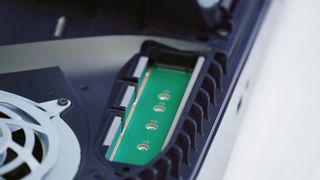hinch said:
The coolers or heatsinks shouldn't be hugely different in price. Reason being vapour chamber coolers are generally more expensive to produce due to the way they are manufactured. Which is most likely why sony opted for standard heatpipes and more aluminum fins for extra cooling capacity. Like they stated if you have enough heatpipes in contact with the heatspreader its offers similar performance - at a cheaper price. Additionally they are able to cover a larger portion of the PCB if there are other components like VRM's, NAND/controllers and other parts to cool. Thermal material cost will be pennies difference for companies, the cost to add it to each board is what I feel is the actual cost differentiator but assuming they have the manufacturing down to a T it shouldn't be an issue. But yeah adding liquid metal to each machine is more complex than adding some thermal compound to the heatspreader and attaching a heatsink. I think the grey plate is just a cover, probably to protect the I/O or SSD from dust. |
It's just hard to believe that, that much metal, can be a lot cheaper. $1.00 on 100 million consoles though is a lot if that were the savings for that part. I figured it must have been considerably cheaper (en masse) to go that route. I didn't consider tying other components into the vast spread of heatsink.
Well I just wonder if the PS5 rumor of going with a more expensive cooling item was the liquid metal. It's really unlikely the fan was smaller or had really cheap bearings/bushings, and the next step up for a heatsink would basically be a vapor chamber. I wonder if they were planning on either liquid metal or a high end carbon based paste? Another rumor said they were still having some heat issues earlier this year. Maybe the carbon based paste wasn't allowing enough heat transfer and it was causing the fan to ramp up too much, causing unacceptable noise as per their goal? They may have spent 2 years working on the liquid metal idea just in case, but if it ended up considerably more expensive, it would still be a question of whether to use it or something cheaper if they could.
I'd guess the NVMe slot plate is more so for anti interference like how the rest of the mobo is covered except for the wifi. I don't see why they wouldn't use the metal shield as a heatsink as well. Otherwise you could probably get away with leaving the metal shield off and applying a slim heatsink to the NVMe stick.
Last edited by EricHiggin - on 08 October 2020PS1 - ! - We must build a console that can alert our enemies.
PS2 - @- We must build a console that offers online living room gaming.
PS3 - #- We must build a console that’s powerful, social, costs and does everything.
PS4 - $- We must build a console that’s affordable, charges for services, and pumps out exclusives.
PRO -%-We must build a console that's VR ready, checkerboard upscales, and sells but a fraction of the money printer.
PS5 - ^ -We must build a console that’s a generational cross product, with RT lighting, and price hiking.
PRO -&- We must build a console that Super Res upscales and continues the cost increases.






















